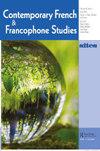灾难电视:加速的时间,望远镜事件,扭曲的感知
IF 0.2
4区 文学
0 LITERATURE, ROMANCE
引用次数: 0
摘要
摘要本文以电视灾难报道对观众时间感知和现实感的影响为研究视角,以丹尼·拉费瑞特(2011)和关口良子(2011)为研究视角,考察电视灾难报道对观众时间感知和现实感的影响。第一本书是以日记的形式写的,讲述了2010年1月12日袭击海地的7.0级毁灭性地震及其后果。第二本书也是一本日记,讲述了2011年3月11日发生在日本的三重灾难——地震、海啸、核泄漏(福岛)。两位作者都认为,更广泛地说,媒体和图像在塑造观众对灾难的看法方面发挥了至关重要的作用,它们构建了一种人造的现实,这种现实借鉴了现实,但同时又强加了自己的时间性、时间顺序和逻辑。此外,laferri本文章由计算机程序翻译,如有差异,请以英文原文为准。
Catastrophe Televised: Accelerated Time, Telescoped Events, Distorted Perceptions
AbstractThis article examines the impact of TV disaster coverage on viewers’ temporal perception and sense of reality, through the lens of Dany Laferrière’s Tout bouge autour de moi (2011) and Ryoko Sekiguchi’s Ce n’est pas un hasard: Chronique japonaise (2011). The first book, written in the form of a journal, covers the devastating magnitude 7.0 earthquake that struck Haiti on January 12, 2010, and its aftermath. The second book, also written as a journal, deals with the triple disaster—earthquake, tsunami, nuclear meltdown (Fukushima)—that occurred in Japan on March 11, 2011. Both authors suggest that the media, and images, more broadly, play a crucial role in fashioning viewers’ perceptions of disaster by constructing an artificial reality that draws on the real, yet at the same time imposes its own temporality, chronological sequence, and logic. In addition, Laferrière’s and Sekiguchi’s reflections on the circulation and constant replay of images of disaster raise ethical questions about the media’s appropriation and commodification of suffering, the traumatic impact of images of atrocity, as well as our widespread addiction to watching disasters unfold in real time on television.Keywords: Dany LaferrièreRyoko SekiguchiimagedisasterTV coveragetemporality Notes1 I am referring to the French title of Boltanski’s book, La Souffrance à distance.2 I am using the distinction proposed by Susan Sontag in Regarding the Pain of Others (40–47) between handmade images (paintings and drawings), which evoke (it is an invented horror by an artist), and photographs, which show and count as evidence, thus provoking both shock and shame in the viewer.3 For a detailed account of how images are redeployed during the news coverage of a catastrophe, one can consult Geoff King’s article “‘Just like a movie’?: 9/11 and Hollywood Spectacle.”Additional informationNotes on contributorsAlina CherryAlina Cherry is Associate Professor of French at Wayne State University in Detroit, where she teaches contemporary French and Francophone literatures and cultures. She is the author of Claude Simon: Fashioning the Past by Writing the Present (Fairleigh Dickinson UP, 2016), as well as articles on Jean-Philippe Toussaint, Marguerite Duras, Claude Simon, and Joan Miró. Her current book project focuses on the 2010 Haiti earthquake and the 2011 triple disaster—earthquake, tsunami, nuclear meltdown—in Japan.
求助全文
通过发布文献求助,成功后即可免费获取论文全文。
去求助
来源期刊

Contemporary French and Francophone Studies
LITERATURE, ROMANCE-
CiteScore
0.30
自引率
0.00%
发文量
43
期刊介绍:
An established journal of reference inviting all critical approaches on the latest debates and issues in the field, Contemporary French & Francophone Studies (formerly known as SITES) provides a forum not only for academics, but for novelists, poets, artists, journalists, and filmmakers as well. In addition to its focus on French and Francophone studies, one of the journal"s primary objectives is to reflect the interdisciplinary direction taken by the field and by the humanities and the arts in general. CF&FS is published five times per year, with four issues devoted to particular themes, and a fifth issue, “The Open Issue” welcoming non-thematic contributions.
 求助内容:
求助内容: 应助结果提醒方式:
应助结果提醒方式:


